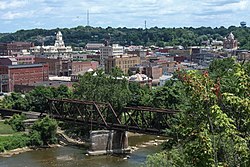힘마트 싱 (시크미즘)
Himmat Singh (Sikhism)바이 힘맛 싱 지 | |
|---|---|
ਹਿੰਮਤ ਸਿੰਘ | |
 파키스탄 펀자브 주 애톡의 코트 파테흐 칸에 있는 버려진 시크교마디 내부에서 그려진 초대 판즈 파이어 중 한 명인 힘마트 싱이 오래된 시크교 프레스코화에 묘사되어 있습니다. | |
| 판즈 파이레 | |
| 재직중 1699 – 1704 또는 1705 | |
| 개인적인 | |
| 태어난 | 힘마트 라이조우르 1661 인도 오디샤의 자간나트 푸리 |
| 죽은 | 1704년 12월 7일 또는 1705년(43세 또는 44세) 인도 펀자브의 참카우르 |
| 사인 | 전사 |
| 종교 | 시크교 |
| 부모님 |
|
| 로 알려진 | 최초의 멤버, 취임식 Panj Pyare; 머리를 위한 구루의 요청에 응답한 세 번째 사람입니다. |
| 직종. | 급수차 |
| 기관 | 칼사 |
| 판즈 파이레 |
|---|
바이힘마트 싱 (1661년–1705년), 힘마트 라이로 태어난, 판즈 파이레의 창립 그룹 또는 시크교의 다섯 명의 사랑받는 사람들의 첫 번째 그룹 중 하나였습니다.
전기
젊은 시절
그는 1661년 오늘날 인도 오디샤의 Jagannath Puri에서 물 [1][2][3]공급자들의 낮은 카스트에서 태어났습니다.그의 가족은 지바르 [4]카스트에 속했습니다.그의 아버지의 이름은 굴자리이고 어머니의 이름은 [5][6]단노입니다.
만년
그는 열 번째 시크교도 고빈드 [7]싱을 섬기기 위해 17세의 나이에 아난드푸르에 도착했습니다.그는 1699년 아난드푸르(현재 타흐트 케스가르 사히브가 [7][8]서 있는 곳)의 언덕 위에서 칼사 명령을 공식화하는 의식 동안 구루의 요청에 머리로 응답한 세 번째 사람이었습니다.칼사 수도회에 세례를 받은 후, 그는 힘맛 [7]싱이라는 이름을 채택했습니다.그는 1704년 또는 1705년 12월 [3][7]7일 참카우르 전투에서 사망했습니다.힘맛 싱은 판닥(사냥꾼)[4]이라는 이름의 무명 바갓의 아바타로 여겨졌습니다.
레퍼런스
- ^ Singh, Mohinder (2000). Punjab 1999. ISBN 9788186565766.
- ^ 싱, 팻완트 (1989).황금 사원, 남아시아 북스.ISBN 962-7375-01-2.
- ^ a b Pruthi, Raj (2004). "Sikh Saints". Sikhism and Indian Civilization. Culture and civilization series. New Delhi: Discovery Publishing House. p. 187. ISBN 81-7141-879-1. OCLC 434576317.
Bhai Himmat Singh (1661 to 1704)
The fifth Beloved One, Bhai Himmat Singh was born to a water carrier in 1661. He died fighting in the battle of Chamkaur in 1704. - ^ a b Fenech, Louis E. (2021). The Cherished Five in Sikh History. New York: Oxford University Press. pp. 1, 46, 48, 61–63, 125. ISBN 978-0-19-753287-4. OCLC 1157751641.
- ^ Singha, H. S. (2000). The encyclopedia of Sikhism (over 1000 entries). New Delhi: Hemkunt Publishers. p. 100. ISBN 81-7010-301-0. OCLC 243621542.
HIMMAT SINGH, BHAI : Bhai Himmat Singh whose original name was Himmat Rai was one of the first Panj Piare who had offered their heads to Guru Gobind Singh on the Baisakhi day of 1699 AD at Anandpur and were thus the first to be initiated into the Khalsa brotherhood. Very little is known about his biographical details. According to one version, he was the son of Gulzari of Puri belonging to the Jhiwar (water carrier) caste. He was born in 1661 AD. After his initiation into the Khaisa he remained in the devoted service of Guru Gobind Singh and died fighting in the battle at Chamkaur in December 1705 AD.
- ^ The Sikh Courier International. Vol. 38–42. Sikh Cultural Society of Great Britain. 1998. p. 18.
- ^ a b c d Singh, Harbans (1995). The Encyclopedia Of Sikhism - Volume II E-L. Punjabi University, Patiala. p. 271.
HIMMAT SINGH, BHAI (1661-1705), one of the Panj Piare, or the Five Beloved, celebrated in Sikh history, was born in 1661 at Jagannath in a low-caste family of water-suppliers. He came to Anandpur at the young age of 17, and attached himself to the service of Guru Gobind Singh. Bhai Himmat, as he was called before his initiation, was one of the five Sikhs who one by one offered to lay down their heads in response to the Guru's successive calls made at an assembly of the Sikhs especially summoned on the occasion of Baisakhi of 1756 Bk corresponding to 30 March 1699. He along with the other four received the vows of the Khalsa at Guru Gobind Singh's hands and was renamed Himmat Singh. Himmat Singh proved a brave warrior and while at Anandpur, he took part in battles with the surrounding hill chiefs and imperial commanders. He died in the battle of Chamkaur on 7 December 1705.
- ^ Tyagi, Vidya Prakash (2009). "Sikhs". Martial Races of Undivided India. Delhi: Kalpaz Publications. p. 173. ISBN 978-81-7835-775-1. OCLC 428923102.
Guru Gobind Singh addressed the congregation from the entryway of a tent pitched on a hill (now called Kesgarh Sahib). He drew his sword and asked for a volunteer who was willing to sacrifice his head. No one answered his first call, nor the second call, but on the third invitation, a person called Daya Ram (later known as Bhai Daya Singh) came forward and offered his head to the Guru. Guru Gobind Singh took the volunteer inside the tent, and emerged shortly, with blood dripping from his sword. He then demanded another head. One more volunteer came forward, and entered the tent with him. Guru again emerged with blood on his sword. This happened three more times. Then the five volunteers came out of the tent unharmed. These five, who were willing to sacrifice their lives for their Guru, were called Panj Piare ("the five beloved ones"). These five volunteers were the first Khalsa Sikhs: Daya Ram (Bhai Daya Singh), Dharam Das (Bhai Dharam Singh), Himmat Rai (Bhai Himmat Singh), Mohkam Chand (Bhai Mohkam Singh), and Sahib Chand (Bhai Sahib Singh).
- 치브바, 케사르 싱, 반사발남 다스덴 프들쉬딘 Kd.찬디가르, 1972
- 크니르 싱, Cur/nlds Pdtshdfu 10.찬디가르, 1968
- 산토흐 싱, 바이, Sn Gur Pratap Suraj Granth.암리차이, 1927년 ~ 1933

